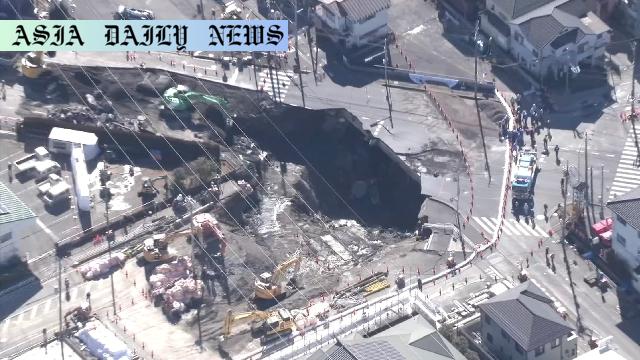Sinkhole remains a devastating challenge as water and debris hamper rescue efforts north of Tokyo.
- Key Point 1: A 74-year-old truck driver remains trapped for over a week in a 15-meter-deep sinkhole in Yashio City, Saitama Prefecture.
- Key Point 2: Debris, water, and safety risks are delaying rescue efforts while officials begin alternative excavation methods.
- Key Point 3: The Japanese government has acknowledged the recurring issues caused by aging sewage pipes, calling for intensive infrastructure repairs.

Overview of the Incident
The massive sinkhole in Yashio City, Saitama Prefecture, continues to capture national and international attention. Occurring on January 28, the catastrophic cave-in at a major intersection trapped a 74-year-old truck driver whose condition remains uncertain. The sinkhole, measuring approximately 15 meters deep, brought rescue operations to a standstill as water and debris crowded the area, posing significant safety risks to rescuers. The situation worsened with the continuous flow of water, suspected to be sewage spilling into the cavity, adding complications to the already challenging scenario.
Challenges in Rescue Operations
Despite persistent efforts, rescue teams have been unable to launch a full-scale operation due to structural hazards posed by the debris and the influx of water. Heavy concrete structures within the sinkhole have hampered the mobilization of heavy machinery. Furthermore, rescue workers have faced difficulties on site in ensuring their own safety. These challenges led officials to initiate the construction of a secondary slope, enabling access to heavy machinery in hopes of clearing debris and allowing for a more efficient search process.
Water Management Efforts
Authorities have taken drastic measures to manage the water levels in the sinkhole in an attempt to facilitate rescue operations. Households and businesses in 12 nearby towns were requested to limit water use for three hours on Tuesday, starting from 2 p.m. The aim of this bold initiative was to determine if the stoppage could significantly reduce the water inflow into the cavity, allowing teams to operate under safer and less obstructive conditions.
Investigation into the Sinkhole’s Causes
Preliminary investigations by local authorities suggest that the sinkhole was caused by the rupture of a sewage pipe located approximately 10 meters underground. This has sparked discussions nationwide about the aging infrastructure throughout Japan, as similar incidents of cave-ins reportedly stem from deteriorating sewage systems. In light of this, the Japanese government has announced plans to focus on the intensive repair and replacement of water supply and sewage systems as part of a broader resilience strategy against natural disasters.
Government’s Response to Infrastructure Concerns
The sinkhole in Yashio City is not an isolated incident. Recent years have seen a disturbing rise in similar events linked to aging water and sewage infrastructure. The Japanese government has recognized the urgency of addressing these issues, stating its intention to compile a new program to promote infrastructural upgrades nationwide. A draft of the program, expected by June, will highlight the significance of making timely repairs and updating systems to prevent future catastrophes.
The Human Impact
While the technical and infrastructural challenges are being addressed, the human element remains at the forefront. The fate of the 74-year-old truck driver remains unknown, a sobering reminder of the real impact these disasters have. Family members, first responders, and the community at large are awaiting a resolution, driven by the hope of a successful recovery amidst the technical hurdles.
Long-Term Solutions
This tragic incident serves as a wake-up call for prioritizing infrastructure monitoring and timely maintenance. Innovative technologies, real-time monitoring systems, and flexible policies are likely to play a critical role in mitigating such events. Enhanced collaboration between local governments, national agencies, and private sectors will be vital in bringing Japan’s urban infrastructure to higher safety standards.
Conclusion
As Yashio City continues to tackle this life-threatening crisis, it also marks a significant moment for the broader discussion on infrastructure resilience. The loss and suffering caused by the sinkhole underline the importance of proactive measures in ensuring public safety. The coming weeks will not only determine the outcome of this complex rescue operation but also potentially shape Japan’s approach to infrastructure safety for years to come.



Commentary
The Urgency of Infrastructure Updates
The Yashio City sinkhole is a grim reminder of how critical infrastructure systems impact every aspect of our lives. The tragedy of a 74-year-old driver being trapped for over a week underscores the human cost of infrastructural failure and delayed maintenance. Japan, a nation renowned for its advanced technology and infrastructure, must now grapple with the vulnerabilities of its aging systems, bringing long-overdue conversations to the forefront.
Learning from the Crisis
This incident highlights the importance of consistent infrastructure monitoring and the use of predictive maintenance measures in averting disasters. Aging sewage pipes may not seem like an urgent issue until catastrophic events like this occur. Local governments are under pressure to balance budgets, but this tragedy calls for a shift in priorities. Allocating resources to inspect, repair, and modernize sewage and water systems is no longer optional—it is a necessity for ensuring public safety.
The Role of Government and Society
It is commendable that the government is addressing the root cause with plans to overhaul outdated systems, but effective implementation remains key. Public awareness and education on infrastructure challenges are also essential. Citizens and businesses must support efforts to temporarily reduce water usage or adapt to changes during repair periods. This collective approach can make systemic overhauls more feasible and sustainable in the long run.
Final Thoughts
While the immediate focus remains on rescuing the trapped driver, this incident has raised critical questions about infrastructure resilience. It should not take a disaster of this scale to inspire meaningful change. The Yashio City sinkhole serves as a stark reminder of the importance of proactive, forward-thinking policies that prioritize human lives and societal well-being above all else.